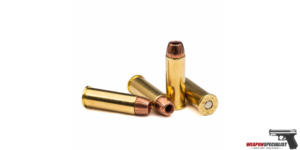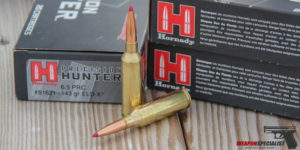Bullet grain refers to the weight, or more precisely the mass, of a bullet used in firearms. It is a crucial characteristic that plays a significant role in determining the bullet’s performance and effectiveness.
The grain measurement system, derived from an ancient unit of weight, is commonly used in the ammunition industry to specify the weight of projectiles.
Understanding bullet grain is essential for shooters and enthusiasts, as it directly influences factors such as velocity, trajectory, recoil, and terminal ballistics.
By carefully selecting the appropriate bullet grain for a particular firearm and application, shooters can optimize accuracy, range, and overall shooting experience.
What is Bullet Grain?
Bullet grains are an important element to know when playing around with rifle scopes. For new users, a very tough challenge is to decide what kind of ammunition would be fit for a bullet.
It is not enough to know about the Ammunition brand, but it is very necessary to have information on other features. For example, the shooter must know what is perfect bullet shape? , what is the perfect bullet type?’ and most importantly what is Bullet Grain?
When anyone buys the ammo, he sees the same caliber on the box as their rifle printed. After expressing the title, a little number with “GR” can be seen. But you are not sure what is meant by that.
Let’s see what is bullet grain and how it could be effective for hunting. Actually, “GR” represents the grain or weight of a bullet. A grain counter is a way or method to measure the size of any bullet. The first thing that needs to understand is that Grain does not tell the amount of powder in cartridges. Grain is an actual unit for mass measurement.
The unit “GR” which is an abbreviation of grain is equal to one 7000th of a pond. In other words, we can say that one pond is equal to 7000 grains. One ounce is equal to 437.5 grains.
GR = 7000TH of a pound | 1 pound = 7000 grains | 1 ounce = 437.5 grains
We often see some bullets listed as grain size and then bullet type like 9mm round is listed as “115gr FMJ”. This will tell us that cartridge is fully loaded with Metal Jacket bullets having a weight of 115 grains.
Impact Of Bullet Grain Weight On Shooting

Now it is important to know how we can choose the exact bullet grain and what are its positive and negative effects on hunting? The bullet for a given cartridge may vary, but each cartridge has a general range of sizes for ammunition. Such as 55 grains is a standard size for AR-15 ammunition. Even for .223 rifles, 40 to over 70 bullet grains can be used.
Bullet weight influences the performance of the bullet. It affects the firearm recoil and even the overall trajectory of a bullet. So terminal ballistics is affected and makes a difference to strike a target. The grain weight has nothing to do with whether you are using the first focal plane or the second focal plane scope.
Along with thinking about bullet weight the second main point of focus is how cartridges can be used more effectively. Weight is not important for the simple” plinking” which shoots at a short to medium distance. For this purpose, you have to buy simple ammunition which fits perfectly with your budget.
Bullet weight matters to shoot for maximum accuracy. It is not easy to decide whether a heavier bullet is better or lighter. So, this is necessary to have the information about each grain before buying the extra box of ammo. To select the right weight bullet for your rifles you should think about your AR and kind of shooting.
Impact of Grain on Recoil
As we all know that bullet weight also affects the recoil. We can’t understand how bullet grain further affects the performance of recoil ?. So, it is very important to know the relation between bullet grain and recoil. So, let’s try to understand this relationship;
The minimum specification for ammunition is referred to as the power factor (PF). PF is the measurement of the momentum of a bullet and is used to determine the perceived recoil during competition.
Power factor can be calculated through the following formula
PF= bullet weight times velocity/1000
For example, according to IPSC for minor shooting, 125 PF is required and a 125-grain bullet travels at 1000 FPS by getting the minimum required 125FP- 125X1000/1000.
Lighter-weight bullets travel faster and reach the same target point as the heavier-weight bullet, so gunpowder is required in more quantity. this shows that time spends in the barrel of both lighter and heavier bullets makes a difference in perceived recoil.
Reason for choosing a heavy bullet
Heavy bullets give several benefits. The main fact for choosing the heavier bullet is the energy delivered at the target point. That improves useful for ”terminal ballistics”. Essentially, for better expansion and deep penetration, you should choose a large-weight bullet.
In some hunting and self-defense cases, heavier bullets play a role as reserved. Because loaded into hunting rifles, a large grain weight bullet released sufficient energy at the target, especially for the humane shots. So, it gives an efficient chance to stop the incoming thread. Only a perfect bullet weight can make your scope the best sniper rifle scope.
When to Choose Lighter Bullet Grain
A lighter-weight bullet can be advantageous if your overall purpose is speed and distance. Speed is important for long-distance shooting because it reduces the chance of a drop. By using the lighter projectile your trajectory remains straight so the distance potential will be longer.
For long-distance shooting practice and hunting, lighter-weight bullets may be best but you have the compromise with energy. It also decreases the recoil. You feel comfortable shooting with the pistol having high recoil, which may be tough in handling.
Relationship of Bullet Chart with Ballistic Table
We see that the bullet grain chart gives the correct ammunition for rifle scopes. Similarly, the ballistics chart or ballistic table also helps us to find out the exact ammunition for our scope. The term, “ballistic chart” is a tool, which tells us the expected trajectory for using a rifle projectile. It is used to determine the physical impact like temperature, wind drift, pressure, and velocity of increasing or decreasing grain.
But there is a basic issue for a large number of hunters. Which is that they do not know how to read the ballistic chart. Because they are not experts. Ever most successful users don’t have any idea about, which grain cartridge should use to dead a target.
Some hunters are curious and some are confused. We always find that, why we are using the Federal’s 110-grain and why not using the Winchester 130-grain ballistic silvertip or Remington’s tone 130- grain.
A ballistics chart may be a graphic form showing the bullet’s flight ranges. And maybe in numbers and column form showing the parameters in lists. Let’s look at Hamady’s ballistic table which is in column form.
Most variable like humidity, temperature, and pressure is included by self because all these have an effective impact on the bullet speed. Airspeed reflects all other parameters.
The velocity line shows the bullet speed in a downrange according to to change distance. The energy line shows the kinetic energy which remains at every range point of distance. While trajectory line tells where the bullet will hit at each distance range
See the Muzzle column and the range value of MOA. Each value of MOA affects the size of Reticles. For little small objective scope gives the -1.5 inches muzzle while, for some large scopes, it may be from -1.75 to -2 inches.
Look at the wind drift line, it shows the deflection of the bullet at various left and right wind ranges. The deflected range seemed to be constant because the flow of direction left or right doesn’t matter. Just keep in mind that the left-flowing wind will deflect in the right direction.
The Difference in Bullet Grain
If you read the above article carefully, then I hope you can make a clear difference in bullet grain before purchasing any box of ammo. As learned about the bullet gain and its effects on the overall performance to shoot a target. So, now you will be able to say that, grain causes a difference while coming from rifle to firing.
Nowadays each manufactured bullet is grouped based on the weight in grains. The range of weight is varying and is bigger than our thinking level. The very small bullet grain is 17 grains like we can see and use a “17 HMR round. The range of heaviest grain is 700, i.e. a .50BMG cartridge.
Such as we know that lighter bullet grain has high speed by keeping maintaining a straighter trajectory at a long distance. But deliver less energy, which is susceptible to air and can be blown off target easily. While this error can be eliminated by using a heavier bullet.
Field test
To understand the difference in bullet grain, let us check the two products of Federal Ammunition for 9mm gun HSTs in 124 grain and HSTs 147 grain. we will see the Muzzle velocity by loaded with the same best scope brands as the same bullet.
| 124 grain HST | 147 grain HST | |
| Shot 1 | 1082 fps | 949 fps |
| Shot 2 | 1082 fps | 922 fps |
| Shot 3 | 1064 fps | 954 fps |
| Shot 4 | 1065 fps | 939 fps |
| Shot 5 | 1073 fps | 935 fps |
The average Muzzle energy of five shoots for 124-grain bullets is 1 073 fps, the calculated energy will be 317-foot pounds. And same energy for heavier 147 grain will be 288-foot pounds. This test concludes that “Bigger is better” because a large bullet conveys more energy to the target and is helpful to stop the thread.
We need to be experts on bullet grain because weight has a clear effect on speed, accuracy, and terminal ballistics. If these features are selected perfectly, then we can make our hunting joyful.
Let’s take a look again at the difference in bullet grain, to become a more knowledgeable and confident shooter;
Heavier bullet grain
- Deliver more energy to the target
- Improve terminal ballistics
- Reserved for self-defense
- create less noise during firing
Lighter bullet grain
- Usable for simply plinking
- Can be valuable over speed and distance
- Best for hunting with a rifle at long distance
- Best for competition and practice
- Eliminate the recoil
Bullet Chart
A bullet chart as “the variation of a bar graph” was developed and introduced by Stephen Few. A bullet chart was prepared after seeing the traditional thermometer chart. Its main purpose of development was to avoid the basic issues of gauges and meters. Because they give little information and take up more space. Not only that but designed with spam and distracting decoration.
If we talk about the bullet chart, considering the meter and gauge the meter and gauge, it would look better. In short, it features a single primary measure. That measure is comparable with other one or more features to enhance meaning like can be compared with target.
For a simple explanation, This will be displayed in the context of qualitative ranges which are poor normal, and excellent. A slight color difference makes the displays dissemble for the colorblind.
Below you can see a simple bullet graph:

Look at the below bullet graph in which each part is identified:

The dark center line identifies the actual value.
A dark vertical line identifies a target value.
Colored brands show the ranges, i.e. poor. Average, good.
Bullet charts may be horizontal or vertical, both types display meaningful information. The selection of charts depends on the types of data. Available space also decides, which type should be used. A vertical bullet has a vertical axis and plays the same information as a horizontal bullet.

Component of bullet chart
The main component of a bullet chart is three, also known as markers. These markers are those points where information and insight are recorded. They are below
1. Target Marker
This marker is commonly called the comparative measure. And used as a target line to compare with other values.
Achievement bar
this line is drawn to show the actual value of the chart, which is real data. The important thing for this line is to give a solid color and should be narrow.
Comparison Range
A color theme can be sawed in the background of the achievement bar to represent the qualitative values. The main purpose of this range is to make a comparison of achievement for other scores. This is helpful for colorblind and visible for white hard copies.
2. Weight of a Bullet
The weight of a bullet varies between 0.02 to 0.4 KG or 0.0441 pounds to 0.88 pounds. You may wonder whether the bullet weight has any impact on the accuracy level of the shooter. The answer is simple yes it impacts the precision up to some extent. The weight of the bullet also depends upon the rifle type and the rifle’s caliber of the bullet.
if you are wondering what is meant by the caliber? it is simply the diameter of the bullet. There are two types of bullet calibers currently used in the gun industry which are called lead bullet and jacketed bullet.
The caliber ranges from 0.56 cm to 1.52 cm. The most important use of the jacketed bullet is for hunting purposes.
3. Bullet Weight Chart
| Caliber | Target Shooting | Hunting | Self-Defense | Common Firearms |
| .22 LR | 40gr | 32gr-45gr | 37gr | Ruger 10/22, Marlin 39A |
| .223 | 55gr | 55gr-64gr | 55gr | Ruger American Ranch, Remington 700 |
| .300 | 150gr | 120gr-205gr | 180gr | Winchester Model 70 |
| .30-06 | 180gr | 150gr-180gr | 165gr | Remington 783, Winchester Model 70 |
| .38 | 130gr | 150-180gr | 130gr | S&W686, Ruger GP100 |
| 5.56x44mm | 45gr | 55gr-62gr | 55gr | AR-15 |
Final thoughts
The bullets chart provides us a way to determine the performance of the present bullets’ grain against the target line. In a scopes game, it is important to know what is bullet grain and how they impact their shooting.
The component makes the bullet chart easier to read and more informational. One another characteristic is that of bullet chart is neat and clean from extra and useless drawings and details.
Last Updated on November 21, 2023 by






